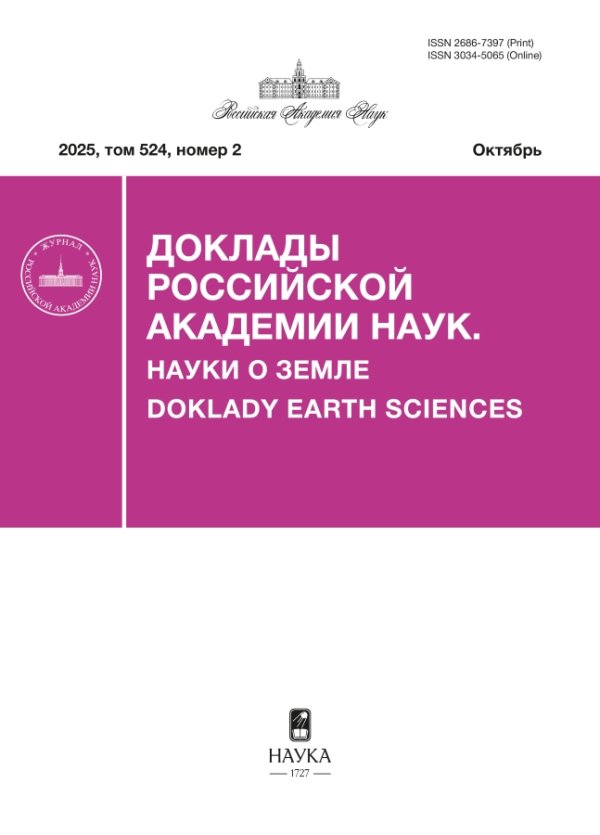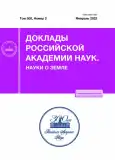Разработка методики мониторинга состояния газогидратных залежей восточно-сибирского шельфа
- Авторы: Чеверда В.А.1, Братчиков Д.С.1, Гадыльшин К.Г.2, Голубева Е.Н.3, Малахова В.В.3, Решетова Г.В.3
-
Учреждения:
- Институт математики им. С.Л. Соболева Сибирского отделения Российской академии наук
- Институт нефтегазовой геологии и геофизики им. А.А. Трофимука Сибирского отделения Российской академии наук
- Институт вычислительной математики и математической геофизики Сибирского отделения Российской академии наук
- Выпуск: Том 508, № 2 (2023)
- Страницы: 245-252
- Раздел: ГЕОФИЗИКА
- Статья получена: 14.10.2023
- Статья опубликована: 01.02.2023
- URL: https://journals.rcsi.science/2686-7397/article/view/135743
- DOI: https://doi.org/10.31857/S2686739722601995
- EDN: https://elibrary.ru/SWANGI
- ID: 135743
Цитировать
Полный текст
Аннотация
Одним из возможных механизмов, вызывающих значительные выбросы метана в атмосферу в пределах арктического шельфа, может быть разложение газогидратов. Их скопления в пределах арктического шельфа формировались практически одновременно с формированием вечной мерзлоты, что способствовало возникновению зоны стабильного существования газогидратов. Последующее затопление шельфа привело к деградации мерзлоты и нарушению условий существования гидратов. Для оценки текущего состояния зоны стабильности используются методы численного моделирования. Для локализации скопления газовых гидратов широко применяются стандартные сейсмические методы, однако мониторинг их физического состояния требует развития принципиально новых подходов на основе решения многопараметрических обратных задач сейсмики. В частности, степень затухания сейсмической энергии является одним из объективных параметров для оценки консолидации газовых гидратов: чем ближе они к началу разложения, тем выше затухание, а значит, тем ниже добротность. Таким образом, методы сейсмического мониторинга состояния газогидратов в целях прогнозирования возможности развития опасных сценариев, должны основываться на решении многопараметрической обратной задачи сейсмики.
Об авторах
В. А. Чеверда
Институт математики им. С.Л. СоболеваСибирского отделения Российской академии наук
Автор, ответственный за переписку.
Email: vova_chev@mail.ru
Россия, Новосибирск
Д. С. Братчиков
Институт математики им. С.Л. СоболеваСибирского отделения Российской академии наук
Email: vova_chev@mail.ru
Россия, Новосибирск
К. Г. Гадыльшин
Институт нефтегазовой геологии и геофизикиим. А.А. Трофимука Сибирского отделения
Российской академии наук
Email: vova_chev@mail.ru
Россия, Новосибирск
Е. Н. Голубева
Институт вычислительной математикии математической геофизики Сибирского отделения Российской академии наук
Email: vova_chev@mail.ru
Россия, Новосибирск
В. В. Малахова
Институт вычислительной математикии математической геофизики Сибирского отделения Российской академии наук
Email: vova_chev@mail.ru
Россия, Новосибирск
Г. В. Решетова
Институт вычислительной математикии математической геофизики Сибирского отделения Российской академии наук
Email: vova_chev@mail.ru
Россия, Новосибирск
Список литературы
- Shakhova N., Semiletov I., Chuvilin E. Understanding the permafrost–hydrate system and associated methane releases in the East Siberian Arctic Shelf // Geosciences. 2019. 9. 251.
- Collett T.S., Lee M.W., Agena W.F., Miller J.J., Lewis K.A., Zyrianova M.V., et al. Permafrost-associated natural gas hydrate occurrences on the Alaska North Slope // Marine and Petroleum Geology. 2011. 28 (2). P. 279–294.
- Rekant P., Bauch H.A., Schwenk T., Portnov A., Gusev E., Spiess V., et al. Evolution of subsea permafrost landscapes in Arctic Siberia since the Late Pleistocene: A synoptic insight from acoustic data of the Laptev Sea // Arktos. 2015. 1 (1). 11.
- Malakhova V. The response of the Arctic Ocean gas hydrate associated with subsea permafrost to natural and anthropogenic climate changes, IOP Conf. Ser. // Earth and Environmental Sci. 2020. 606. 012035.
- Dmitrenko I., Kirillov S., Tremblay L., Kassens H., Anisimov O., Lavrov S., Razumov S., Grigoriev M. Recent changes in shelf hydrography in the Siberian Arctic: Potential for subsea permafrost instability // J. Geophys. Res. 2011. V. 116: C10027.
- Golubeva E., Kraineva M., Platov G., Iakshina D., Tarkhanova M. Marine Heatwaves in Siberian Arctic Seas and Adjacent Region // Remote Sens. 2021. 13. 4436.
- Gavrilov A., Malakhova V., Pizhankova E., Popova A. Permafrost and gas hydrate stability zone of the glacial part of the East Siberian shelf // Geosciences. 2020. 10. P. 484.
- Юрганов Л.Н., Лейфер А. Оценки эмиссии метана от некоторых арктических и приарктических районов по данным орбитального интерферометра IASI // Современные проблемы дистанционного зондирования Земли из космоса. 2016. Т. 13. № 3. С. 173–183.
- Malakhova V., Eliseev A. Salt diffusion effect on the submarine permafrost state and distribution as well as on the stability zone of methane hydrates on the Laptev Sea shelf // Ice and Snow. 2020. 60. P. 533–546.
- Davies J.H. Global map of Solid Earth surface heat flow // Geochem. Geophyst. Geosyst. 2013. V. 14 (10). P. 4608–4622.
- Chuvilin E., Bukhanov B., Davletshina D., Grebenkin S., Istomin V. Dissociation and self‑preservation of gas hydrates in permafrost // Geosciences. 2018. V. 8. P. 431–442.
- Sun Y.F., Goldberg D. Hydrocarbon signatures from high-resolution attenuation profiles, SEG Technical Program Expanded Abstracts. 1998. P. 996–999.
- Romanov V.G. The two-dimensional inverse problem for the equation of viscoelasticity // Siberian mathematical journal. 2012. V. 53 (6). P. 1401–1412.
- Liu H.-P., Anderson D.L., Kanamori H. Velocity dispersion due to anelasticity; implications for seismology and mantle composition // Geophysics. 1976. V. 47. P. 41–58.
- Hao Q., Greenhalgh S. The generalized standard-linear-solid model and the corresponding viscoacoustic wave equations revisited // Geophysical Journal International. 2019. 219. P. 1939–1947.
- Knyazev A.V., Lashuk I. Steepest Descent and Conjugate Gradient Methods with Variable Preconditioning // SIAM Journal on Matrix Analysis and Applications. 2008. 29 (4). 1267.
Дополнительные файлы














